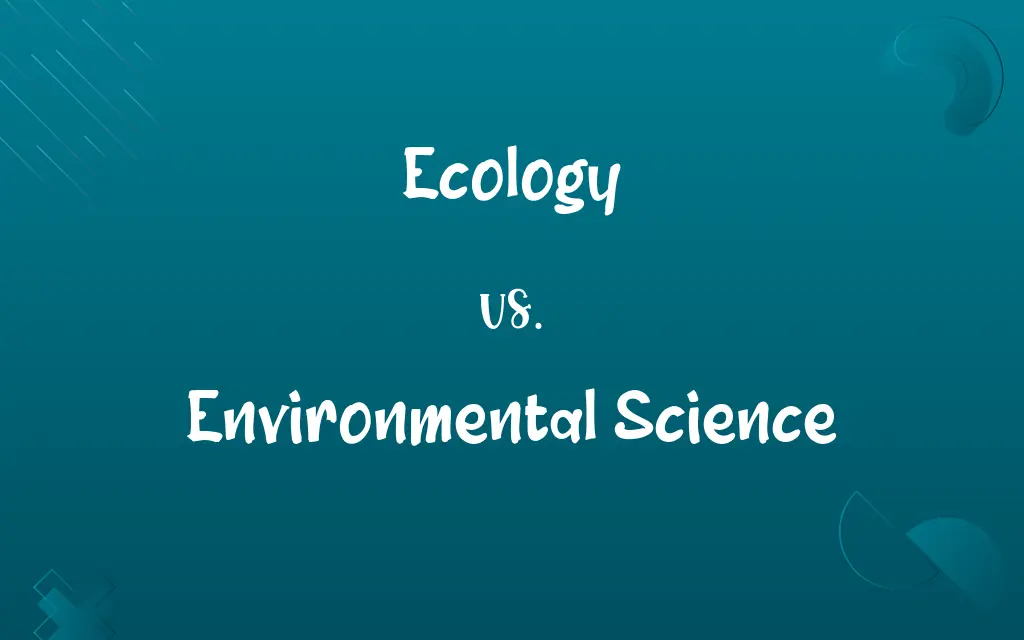Ecology vs. Environmental Science: Know the Difference

By Shumaila Saeed || Published on February 27, 2024
Ecology focuses on the relationships between organisms and their environment; Environmental Science studies the interaction of physical, chemical, and biological components of the environment.

Key Differences
Ecology is a branch of biology that studies the interactions among organisms and their environment. Environmental Science is an interdisciplinary field that includes not only biological, but also physical and chemical aspects of the environment.
Shumaila Saeed
Feb 27, 2024
The objective of ecology is to understand the relationships and dynamics within ecosystems. Environmental Science aims to solve practical problems related to the environment, encompassing pollution control, resource management, and conservation.
Shumaila Saeed
Feb 27, 2024
Ecology often focuses on specific interactions within an ecosystem, like predator-prey relationships. Environmental Science takes a broader approach, studying how human activities impact the environment and vice versa.
Shumaila Saeed
Feb 27, 2024
Ecologists primarily use biological methods to study life processes and adaptations. Environmental scientists employ a wide range of tools from biology, chemistry, physics, and earth sciences to address environmental issues.
Shumaila Saeed
Feb 27, 2024
Ecology contributes to understanding biodiversity and the functioning of ecosystems. Environmental Science applies this understanding towards developing sustainable solutions for environmental challenges.
Shumaila Saeed
Feb 27, 2024
ADVERTISEMENT
Comparison Chart
Primary Focus
Interactions among organisms and their environment
Interaction of biological, physical, chemical components of the environment
Shumaila Saeed
Feb 27, 2024
Main Objective
Understanding ecosystem dynamics
Solving environmental problems
Shumaila Saeed
Feb 27, 2024
Level of Study
Specific ecological interactions
Broader environmental impacts and solutions
Shumaila Saeed
Feb 27, 2024
Methodological Approach
Biological methods and studies
Multidisciplinary, including biology, chemistry, physics
Shumaila Saeed
Feb 27, 2024
Practical Application
Biodiversity and ecosystem functioning
Sustainable environmental management
Shumaila Saeed
Feb 27, 2024
ADVERTISEMENT
Ecology and Environmental Science Definitions
Ecology
The study of relationships between living organisms and their environment.
Ecology helps us understand how pollution affects a lake's fish population.
Shumaila Saeed
Jan 20, 2024
Environmental Science
Analysis of the impact of human activity on the natural environment.
Environmental science is crucial for understanding and mitigating the effects of industrialization.
Shumaila Saeed
Jan 20, 2024
Ecology
Investigation of ecosystems and the biodiversity within them.
Ecologists are studying the impact of invasive species on local ecology.
Shumaila Saeed
Jan 20, 2024
Environmental Science
Research and application in areas like conservation, pollution control, and resource management.
Environmental scientists develop methods for sustainable resource use.
Shumaila Saeed
Jan 20, 2024
Ecology
A branch of biology focusing on the interaction of organisms with each other and their surroundings.
The ecology of the rainforest is complex and diverse.
Shumaila Saeed
Jan 20, 2024
ADVERTISEMENT
Environmental Science
A field that integrates ecological concepts with other scientific disciplines for environmental problem-solving.
Environmental science plays a key role in developing renewable energy sources.
Shumaila Saeed
Jan 20, 2024
Ecology
Analysis of energy flow and material cycling in natural habitats.
The ecology of the wetlands involves studying nutrient cycling.
Shumaila Saeed
Jan 20, 2024
Environmental Science
An interdisciplinary field combining biology, chemistry, and physics to understand the environment.
Environmental science courses cover topics ranging from soil science to atmospheric chemistry.
Shumaila Saeed
Jan 20, 2024
Ecology
The science of the relationships between organisms and their environments.
Shumaila Saeed
Jan 20, 2024
Environmental Science
The study of the environment and the solution of environmental problems.
Environmental science addresses issues like climate change and pollution.
Shumaila Saeed
Jan 20, 2024
Ecology
(biology) The branch of biology dealing with the relationships of organisms with their environment and with each other.
Shumaila Saeed
Jan 20, 2024
Ecology
The branch of biology concerned with the various relations of animals and plants to one another and to their surrounding environment.
Shumaila Saeed
Jan 20, 2024
Ecology
The environment as it relates to living organisms;
It changed the ecology of the island
Shumaila Saeed
Jan 20, 2024
Ecology
The branch of biology concerned with the relations between organisms and their environment
Shumaila Saeed
Jan 20, 2024
Ecology
Examination of ecological processes like predation, competition, and symbiosis.
Understanding the ecology of a region is vital for conservation efforts.
Shumaila Saeed
Jan 20, 2024
Repeatedly Asked Queries
Are ecology and environmental science the same?
No, ecology is a sub-discipline of biology, while environmental science is an interdisciplinary field.
Shumaila Saeed
Feb 27, 2024
How does environmental science help with pollution?
Environmental science develops methods for pollution control and mitigation.
Shumaila Saeed
Feb 27, 2024
What is ecology?
Ecology is the study of interactions between organisms and their environment.
Shumaila Saeed
Feb 27, 2024
What subjects does environmental science integrate?
Environmental science integrates biology, chemistry, physics, and earth sciences.
Shumaila Saeed
Feb 27, 2024
What does environmental science encompass?
Environmental science includes the study of biological, physical, and chemical aspects of the environment.
Shumaila Saeed
Feb 27, 2024
What are ecological niches?
Ecological niches refer to the specific roles and functions that organisms play within an ecosystem.
Shumaila Saeed
Feb 27, 2024
How does environmental science contribute to policy and decision-making?
Environmental scientists provide valuable data and analysis to inform policies related to environmental protection and resource management.
Shumaila Saeed
Feb 27, 2024
What are some real-world applications of ecological research?
Ecological research informs conservation efforts, land management, and the understanding of how ecosystems respond to environmental changes.
Shumaila Saeed
Feb 27, 2024
What tools do ecologists use?
Ecologists use biological methods to study life processes and ecological interactions.
Shumaila Saeed
Feb 27, 2024
Is ecology limited to studying plants and animals?
No, ecology also studies microorganisms, habitats, and ecological processes.
Shumaila Saeed
Feb 27, 2024
What is the difference between a community and an ecosystem in ecology?
A community consists of all the populations of different species living in the same area, while an ecosystem includes both living organisms and their physical environment.
Shumaila Saeed
Feb 27, 2024
What are abiotic factors in ecology?
Abiotic factors are non-living components of an ecosystem, such as temperature, water, and soil.
Shumaila Saeed
Feb 27, 2024
What is the role of environmental impact assessments (EIAs)?
EIAs are used to evaluate potential environmental consequences of proposed projects or actions, helping to minimize negative impacts.
Shumaila Saeed
Feb 27, 2024
What are the major environmental challenges facing the world today?
Major challenges include climate change, biodiversity loss, air and water pollution, deforestation, and resource depletion.
Shumaila Saeed
Feb 27, 2024
Can ecology guide conservation efforts?
Yes, ecological studies are essential for effective conservation planning.
Shumaila Saeed
Feb 27, 2024
How can individuals make a positive impact on the environment?
Individuals can reduce their environmental footprint by conserving energy, reducing waste, supporting sustainable practices, and advocating for environmental protection.
Shumaila Saeed
Feb 27, 2024
How do ecologists measure population density?
Population density is often measured as the number of individuals of a species per unit area or volume.
Shumaila Saeed
Feb 27, 2024
Share this page
Link for your blog / website
HTML
Link to share via messenger
About Author
Written by
Shumaila SaeedShumaila Saeed, an expert content creator with 6 years of experience, specializes in distilling complex topics into easily digestible comparisons, shining a light on the nuances that both inform and educate readers with clarity and accuracy.









































































